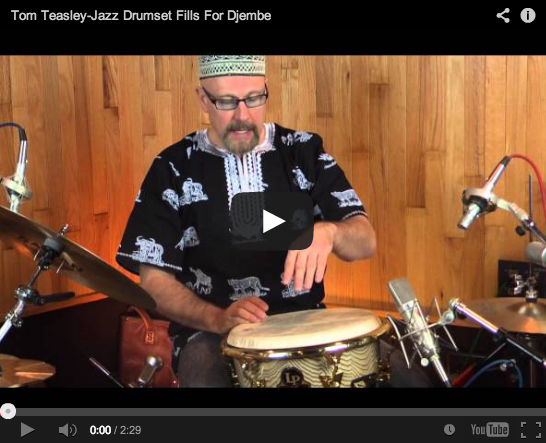Home > Study with Tom > Free Online World Percussion Workshop
- Home
- Projects / Performances / Creative Services
- Award-Winning Solo Percussion Concerts and Word-Beat
- Educational School Assembly / Family Programs
- Live Film Score Concerts
- "Global Standards" World/Jazz Ensemble
- Multi-Media Presentation Sounds You Can SEE
- Sound Installation
- Sound Design for Theatre / Film / TV
- Recording Session Services
- Healing Therapeutic Sound and Community Drumming
- Study with Tom
- Store
- Calendar
- Contact
- Blog
PASIC 2023 pdf
PASIC 2023 pdfWelcome to my World Percussion Workshop. I will be uploading new lessons, articles and videos weekly. I hope you will check back often. Feel free to send a message to me with any comments or topics you would like to see covered in the future. If this material is appealing to you feel free to contact me about a lesson in my studio or via Skype. You may also want to subscribe to my YouTube channel. Thank you and I look forward to staying in touch!
Instruction for students in all instruments (Suzuki, Carl Orff…)
The use of the South Indian rhythmic solfege, Solkattu is used to connect correct sounds and rhythms with the voice. Proper sound production on the instruments is followed by incorporating traditional world rhythms with American Jazz, Funk and proper playing techniques.
Combining digital technology with world percussion Demonstrations on digital looping and DJ technology are combined with world percussion to create a performance concept that spans time and geographic location.
Lesson 1: This is an article that appeared in Jazz Improv Magazine as well as the Sabian Newsletter. It has variations and exercises on the African Ewe Gadzo Ganugbagba rhythm also known as the 6/8 bell pattern. For your convenience I have provided this as a PDF.
Download PDFLesson 2: This current theme is jazz fill development for the djembe.
In my studies with drumset master Joe Morello we would often use the text by Ted Reed, "Progressive Steps To Syncopation" to develop technique. I like to use it in my teaching because it gives western trained drummers a familiar reference point. For this exercise we will interpret the eighth notes in a jazz triplet feel. The eighth notes are played as open tones and the quarter notes as bass tones. The un-played, but implied, remaining triplets are played as very soft touch strokes. The result is a syncopated melodic line between the eighth notes and quarter notes with the touch strokes serving as an accompaniment. To see an example of me performing this concept on page 38 from the Ted Reed book refer to this link.
Lesson 3: Exercise for 6/8 bell pattern using Ted Reed "Progressive Steps To Syncopation"
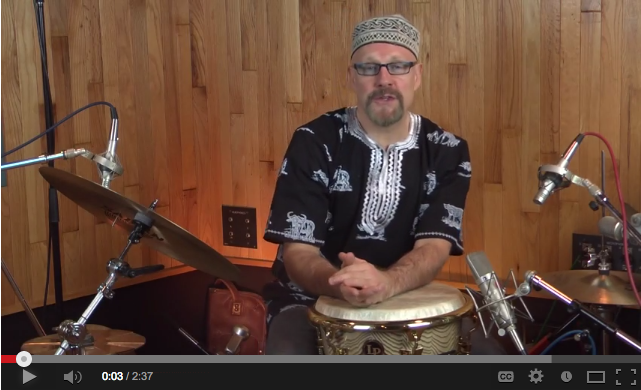 This is a good exercise to accompany Lesson 1's article about Ewe Gadzo Ganugbagzo, also know as 6/8 Bell, Hoe Blade and more. Jazz great Billy Hart sometimes refers to it as 6/8 cascara as it relates to ride cymbal patterns. Regardless of the name, it is a useful piece in a drummers toolkit. To be able to play 4 part coordination in sync with it is very useful in today's rhythmic world. The exercises from this video are adapted from coordination exercises I play on the drumset. I hope that you find them enjoyable and helpful!
This is a good exercise to accompany Lesson 1's article about Ewe Gadzo Ganugbagzo, also know as 6/8 Bell, Hoe Blade and more. Jazz great Billy Hart sometimes refers to it as 6/8 cascara as it relates to ride cymbal patterns. Regardless of the name, it is a useful piece in a drummers toolkit. To be able to play 4 part coordination in sync with it is very useful in today's rhythmic world. The exercises from this video are adapted from coordination exercises I play on the drumset. I hope that you find them enjoyable and helpful!
Lesson 4: Pandeiro patterns applied to djembe with using Ted Reed's "Progressive Steps To Syncopation"
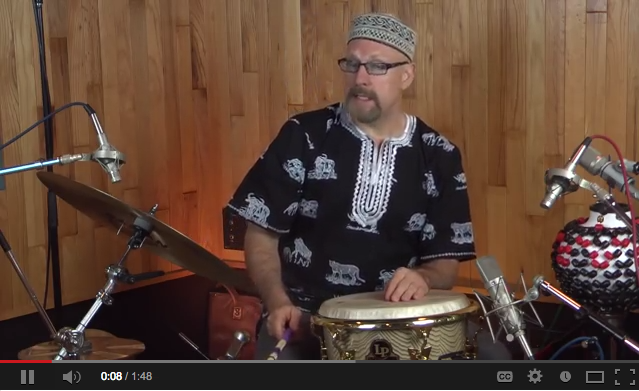 One of the threads that runs through my hybrid approach is interchanging drumming techniques, traditions and patterns through a variety of styles. I'm enjoying exploring the pandeiro stroke on the djembe. The first note should be as resonate as possible. Frame drummers may want to reference a full sounding "dum" stroke. The heel tip strokes are similar to the strokes I use on congas and djembe to produce a double stroke roll. In this video I'm actually playing it with my left hand to allow my right hand interpret "ride" patterns. I suggest playing the pattern with both hands. It is helpful to play it with both hands in unison to develop evenness between the hands. Have fun and experiment with your own variations!
One of the threads that runs through my hybrid approach is interchanging drumming techniques, traditions and patterns through a variety of styles. I'm enjoying exploring the pandeiro stroke on the djembe. The first note should be as resonate as possible. Frame drummers may want to reference a full sounding "dum" stroke. The heel tip strokes are similar to the strokes I use on congas and djembe to produce a double stroke roll. In this video I'm actually playing it with my left hand to allow my right hand interpret "ride" patterns. I suggest playing the pattern with both hands. It is helpful to play it with both hands in unison to develop evenness between the hands. Have fun and experiment with your own variations!
Lesson 5: Jazz Fill Development For Doumbek
 This lesson make a nice companion to lesson 2 in that it takes the triplet fill exercises we were working on the djembe, and now apply them to the doumbek or darbuka. Again, the inspiration is derived from Alan Dawson drumset technique. This time the implied triplets are played with a Turkish style split hand technique with the left (or non dominant) hand using the second and fourth fingers. I'm using Ted Reed's "Progressive Steps To Syncopation" as it is the best selling drum book of all time and likely to be in your collection. I urge you to also use traditional Middle Eastern rhythms as well as the rhythms to jazz standards to expand you vocabulary! Start slow and have fun!
This lesson make a nice companion to lesson 2 in that it takes the triplet fill exercises we were working on the djembe, and now apply them to the doumbek or darbuka. Again, the inspiration is derived from Alan Dawson drumset technique. This time the implied triplets are played with a Turkish style split hand technique with the left (or non dominant) hand using the second and fourth fingers. I'm using Ted Reed's "Progressive Steps To Syncopation" as it is the best selling drum book of all time and likely to be in your collection. I urge you to also use traditional Middle Eastern rhythms as well as the rhythms to jazz standards to expand you vocabulary! Start slow and have fun!
Lesson 6: Exercises For a the Development Of One Hand Tumbao
 This next exercise is one of my favorites but can be rather challenging so I recommend going slow and taking small amounts at a time. Even though most of you will know the basic two hand version I demonstrate it at the beginning of the video. For the one hand version I choose to begin on the tip as opposed to the heel. I feel like it lays better for me and doesn't require the double tip before and during the slap. If starting with the heel feels better for you, by all means use that! I demonstrate a few foot patterns including a bossa and a clave pattern. I'm also using the rhythm to some Thelonious Monk tunes as source material As these are jazz inspired exercises I urge you to experiment with jazz tunes to increase your vocabulary, song repertoire and knowledge to form and structure. Enjoy and go slow!
This next exercise is one of my favorites but can be rather challenging so I recommend going slow and taking small amounts at a time. Even though most of you will know the basic two hand version I demonstrate it at the beginning of the video. For the one hand version I choose to begin on the tip as opposed to the heel. I feel like it lays better for me and doesn't require the double tip before and during the slap. If starting with the heel feels better for you, by all means use that! I demonstrate a few foot patterns including a bossa and a clave pattern. I'm also using the rhythm to some Thelonious Monk tunes as source material As these are jazz inspired exercises I urge you to experiment with jazz tunes to increase your vocabulary, song repertoire and knowledge to form and structure. Enjoy and go slow!
Lesson 7: Back-Beat Exercises for Frame Drum
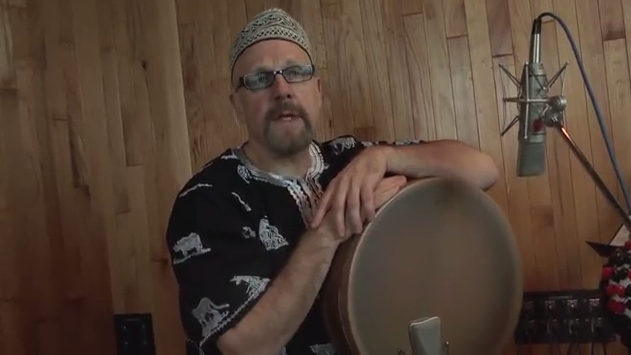 This lesson works with some backbeat exercises for frame drum with a bossa type foot pattern. I'm employing dum, ka and pah sounds. Once again I'm using the Ted Reed book as source material. The "line" is played as dum except on beats 2 and 4 which is always played as pah to give a steady backbeat feel. The unplayed but implied eighth notes are filled in with ka on the left hand. The rhythmic inspiration comes from Al Jackson and other great backbeat drumset players. I hope you have fun and enjoy this exercise.
This lesson works with some backbeat exercises for frame drum with a bossa type foot pattern. I'm employing dum, ka and pah sounds. Once again I'm using the Ted Reed book as source material. The "line" is played as dum except on beats 2 and 4 which is always played as pah to give a steady backbeat feel. The unplayed but implied eighth notes are filled in with ka on the left hand. The rhythmic inspiration comes from Al Jackson and other great backbeat drumset players. I hope you have fun and enjoy this exercise.
Lesson 8 : Demonstration Combining Doumbek, Djembe and Foot Patterns
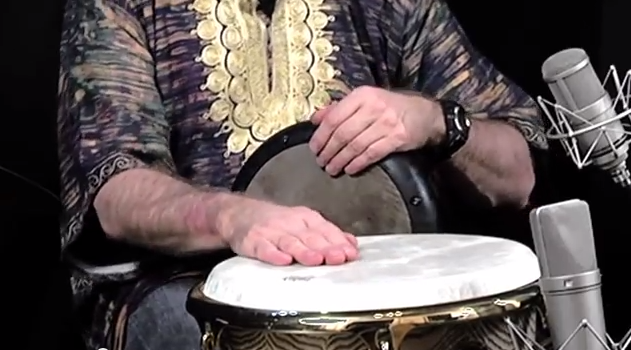 This lesson is a brief tutorial on combining doumbek, djembe, cymbals and foot patterns. There is a demonstration on combining the Turkish "split finger" technique on doumbek with the heel-tip technique (originally used on conga and adapted by me) on djembe. I demonstrate a few rudiments with this concept. This is the beginning of how I combine a variety of hand drums to create a hybrid drum kit to replicate a traditional drumset approach, which was my first instrument.
This lesson is a brief tutorial on combining doumbek, djembe, cymbals and foot patterns. There is a demonstration on combining the Turkish "split finger" technique on doumbek with the heel-tip technique (originally used on conga and adapted by me) on djembe. I demonstrate a few rudiments with this concept. This is the beginning of how I combine a variety of hand drums to create a hybrid drum kit to replicate a traditional drumset approach, which was my first instrument.
Lesson 9: Demonstration Combining Riqq, Djembe, Cymbals and Foot Patterns
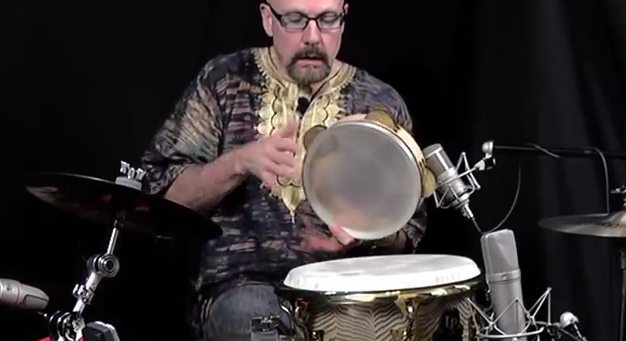 This lesson continues with the above concept of creating a hybrid kit of world percussion instruments. This time I'm combining riqq with djembe, cymbals and foot patterns. I find the low bass tones on the djembe a very nice complement to the higher frequencies of the riqq. I've also chosen to use a pandeiro as the bass drum instrument for the same reason as it has an amazing low register. I'm also playing with some call and response ideas with the block and cymbals. I hope you enjoy this multi-cultural hybrid!
This lesson continues with the above concept of creating a hybrid kit of world percussion instruments. This time I'm combining riqq with djembe, cymbals and foot patterns. I find the low bass tones on the djembe a very nice complement to the higher frequencies of the riqq. I've also chosen to use a pandeiro as the bass drum instrument for the same reason as it has an amazing low register. I'm also playing with some call and response ideas with the block and cymbals. I hope you enjoy this multi-cultural hybrid!
Lesson 10: Demonstration Combining Cooperman Slapback 99, Djembe and Foot Patterns
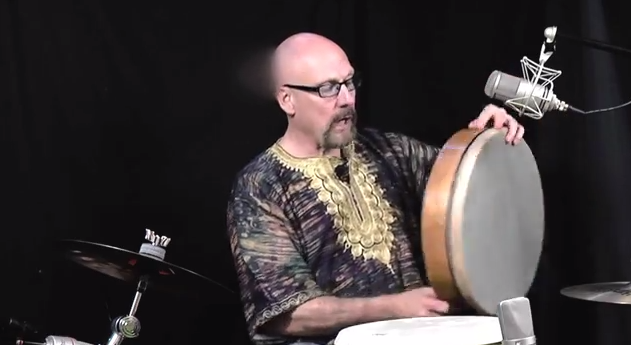 This tutorial combines the Cooperman Slapback 99, a frame drum with metal shot inside to give a shaker like effect, with djembe, foot patterns and more. It's interesting how exciting the shot inside gives another color to the sound. It's also interesting that the sound has a high register and longer decay than the struck drums. This drum has become a favorite of mine recently. Enjoy!
This tutorial combines the Cooperman Slapback 99, a frame drum with metal shot inside to give a shaker like effect, with djembe, foot patterns and more. It's interesting how exciting the shot inside gives another color to the sound. It's also interesting that the sound has a high register and longer decay than the struck drums. This drum has become a favorite of mine recently. Enjoy!
